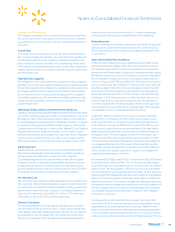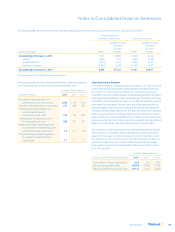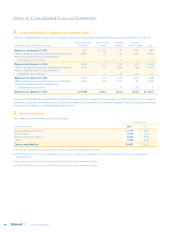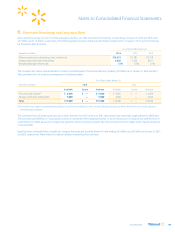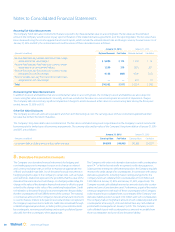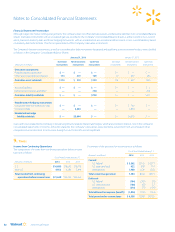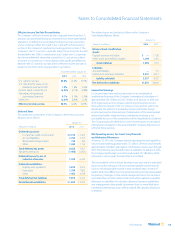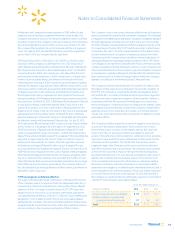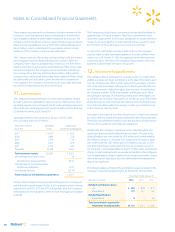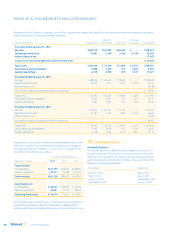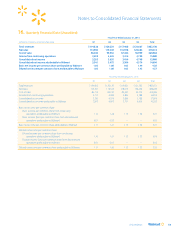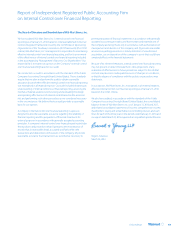Walmart 2016 Annual Report Download - page 53
Download and view the complete annual report
Please find page 53 of the 2016 Walmart annual report below. You can navigate through the pages in the report by either clicking on the pages listed below, or by using the keyword search tool below to find specific information within the annual report.
51Only Walmart
The Company uses derivative financial instruments for the purpose of
hedging its exposure to interest and currency exchange rate risks and,
accordingly, the contractual terms of a hedged instrument closely mirror
those of the hedged item, providing a high degree of risk reduction and
correlation. Contracts that are effective at meeting the risk reduction and
correlation criteria are recorded using hedge accounting. If a derivative
financial instrument is recorded using hedge accounting, depending
on the nature of the hedge, changes in the fair value of the instrument
will either be offset against the change in fair value of the hedged assets,
liabilities or firm commitments through earnings or be recognized in
accumulated other comprehensive income (loss) until the hedged item
is recognized in earnings. Any hedge ineffectiveness is immediately
recognized in earnings. The Company’s net investment and cash flow
instruments are highly effective hedges and the ineffective portion has
not been, and is not expected to be, significant. Instruments that do
not meet the criteria for hedge accounting, or contracts for which the
Company has not elected hedge accounting, are recorded at fair value
with unrealized gains or losses reported in earnings during the period
of the change.
Fair Value Instruments
The Company is a party to receive fixed-rate, pay variable-rate interest
rate swaps that the Company uses to hedge the fair value of fixed-rate
debt. The notional amounts are used to measure interest to be paid or
received and do not represent the Company’s exposure due to credit
loss. The Company’s interest rate swaps that receive fixed-interest rate
payments and pay variable-interest rate payments are designated as
fair value hedges. As the specific terms and notional amounts of the
derivative instruments match those of the fixed-rate debt being hedged,
the derivative instruments are assumed to be perfectly effective hedges.
Changes in the fair values of these derivative instruments are recorded
in earnings, but are offset by corresponding changes in the fair values
of the hedged items, also recorded in earnings, and, accordingly, do not
impact the Company’s Consolidated Statements of Income. These fair
value instruments will mature on dates ranging from October 2020 to
April 2024.
Net Investment Instruments
The Company is a party to cross-currency interest rate swaps that the
Company uses to hedge its net investments. The agreements are contracts
to exchange fixed-rate payments in one currency for fixed-rate payments
in another currency. All changes in the fair value of these instruments are
recorded in accumulated other comprehensive income (loss), offsetting
the currency translation adjustment of the related investment that is
also recorded in accumulated other comprehensive income (loss).
These instruments will mature on dates ranging from October 2023 to
February 2030.
The Company has issued foreign-currency-denominated long-term debt
as hedges of net investments of certain of its foreign operations. These
foreign-currency-denominated long-term debt issuances are designated
and qualify as nonderivative hedging instruments. Accordingly, the foreign
currency translation of these debt instruments is recorded in accumulated
other comprehensive income (loss), offsetting the foreign currency
translation adjustment of the related net investments that is also recorded
in accumulated other comprehensive income (loss). At January 31, 2016
and January 31, 2015, the Company had ¥10 billion and ¥100 billion,
respectively, of outstanding long-term debt designated as a hedge
of its net investment in Japan, as well as outstanding long-term debt of
£2.5 billion at January 31, 2016 and January 31, 2015 that was designated as
a hedge of its net investment in the United Kingdom. These nonderivative
net investment hedges will mature on dates ranging from July 2020 to
January 2039.
Cash Flow Instruments
The Company was a party to receive variable-rate, pay fixed-rate interest
rate swaps that matured in July 2015. The Company used these interest
rate swaps to hedge the interest rate risk of certain non-U.S. denominated
debt. The swaps were designated as cash flow hedges of interest expense
risk. Amounts reported in accumulated other comprehensive income
(loss) related to these derivatives were reclassified from accumulated
other comprehensive income (loss) to earnings as interest was expensed
for the Company’s variable-rate debt, converting the variable-rate
interest expense into fixed-rate interest expense.
The Company is also a party to receive fixed-rate, pay fixed-rate
cross-currency interest rate swaps to hedge the currency exposure
associated with the forecasted payments of principal and interest of
certain non-U.S. denominated debt. The swaps are designated as cash
flow hedges of the currency risk related to payments on the non-U.S.
denominated debt. The effective portion of changes in the fair value of
derivatives designated as cash flow hedges of foreign exchange risk is
recorded in accumulated other comprehensive income (loss) and is
subsequently reclassified into earnings in the period that the hedged
forecasted transaction affects earnings. The hedged items are recognized
foreign currency-denominated liabilities that are re-measured at spot
exchange rates each period, and the assessment of effectiveness (and
measurement of any ineffectiveness) is based on total changes in the
related derivative’s cash flows. As a result, the amount reclassified into
earnings each period includes an amount that offsets the related
transaction gain or loss arising from that re-measurement and the
adjustment to earnings for the period’s allocable portion of the initial
spot-forward difference associated with the hedging instrument. These
cash flow instruments will mature on dates ranging from April 2022 to
March 2034.
Notes to Consolidated Financial Statements




